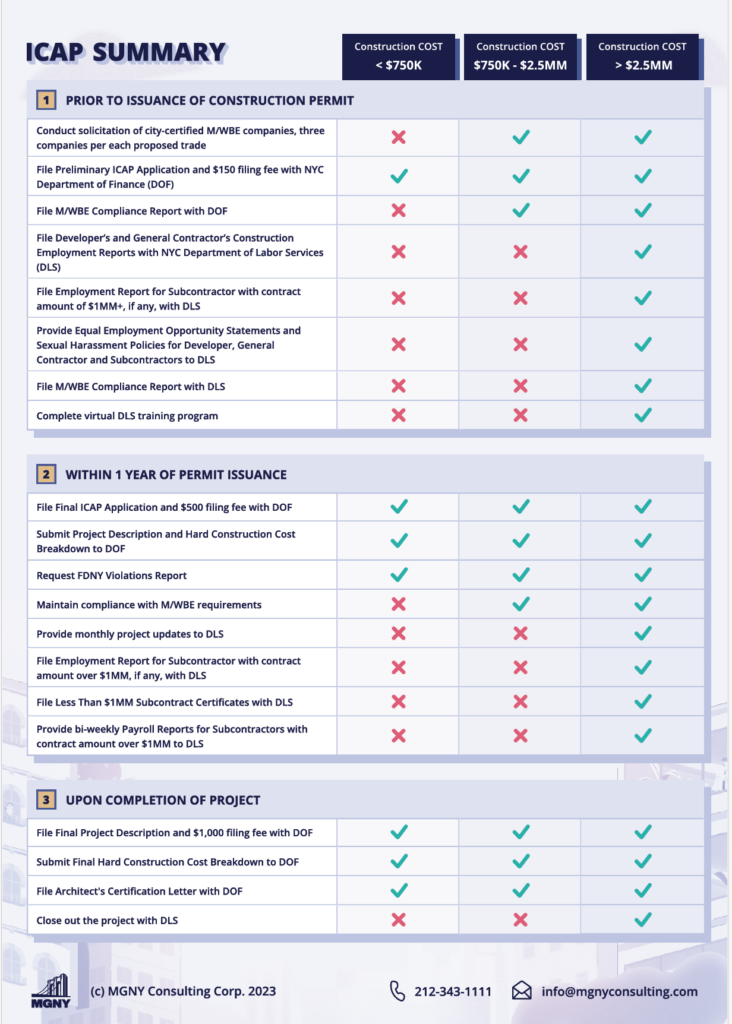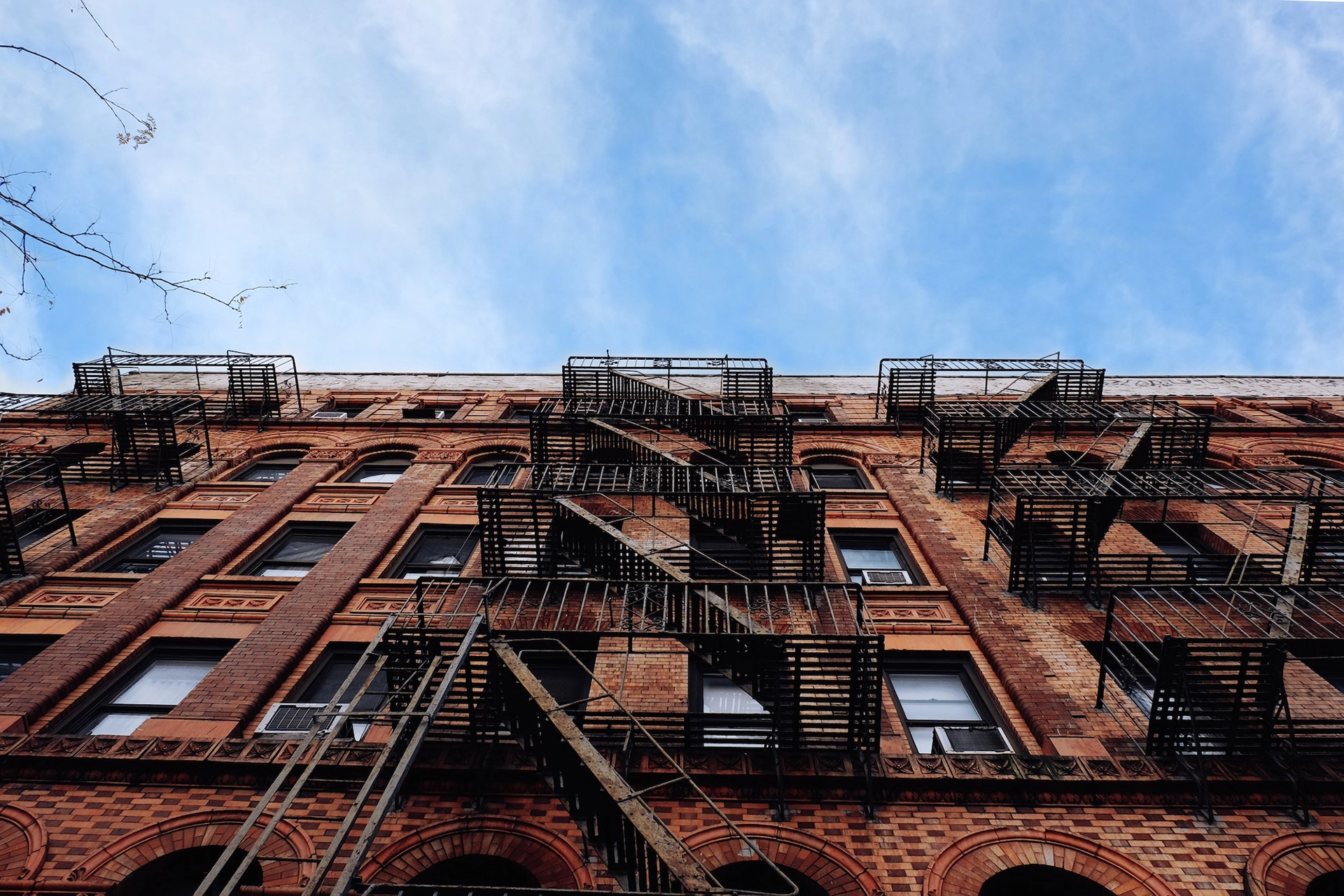Our clients frequently ask whether their projects are eligible for New York City’s widely used Industrial & Commercial Abatement Program (ICAP). Although developers and property-owners have been utilizing ICAP (as well as its predecessor, ICIP) for a number of years, the question of project’s eligibility remains somewhat tricky to answer. In this post we’ll discuss several of the common questions around the program and project eligibility, and how to learn more for your own project.
The Overview of ICAP Tax Benefits
ICAP provides property tax abatement on certain industrial and commercial building projects for up to 25 years. To be eligible for ICAP, property owners and developers should be aware of certain initial qualifiers before applying, such as the project’s geographic location, amount of expenditures, completion timeline, and types of eligible construction or improvements. MGNY has a deep understanding of all ICAP requirements and regularly advises clients on the most effective way to meet them.
Geographic Limitations
- Locations in the City – New construction of commercial properties is eligible anywhere in New York City except for the areas between Murray, Frankfort and Dover, and 96th Street in Manhattan. Renovations are eligible anywhere in the New York City except between 59th and 96th Streets in Manhattan. There are some additional benefits available in the Garment District and in Lower Manhattan.
- Special Areas – each of the five boroughs contains a range of blocks that are in the so-called special area, allowing for 25-year benefits for particular project types.
Requirements for ICAP Tax Benefits
The major requirements for the program include:
- Minimum Required Expenditure (MRE) – For a project to be eligible, an MRE of at least 30% of the property’s Taxable Assessed Value must be spent no more than four years from the date of the first permit for your project. For industrial projects, additional benefits kick in if at least 40% of the Taxable Assessed Value is spent in that time frame.
- Time Frame – Construction must be completed within five years of receiving the building permit or from the start of construction (if there is no permit).
There are some additional limits to the program that developers should be aware of which apply to come into effect for certain types of projects. Examples include:
- Residential Considerations – If more than 20% of the rentable space is dedicated to residential space, apportionment may be required, resulting in a change in the project.
- Utilities are Generally Ineligible – With the exception of electricity generating units, utilities are not eligible for ICAP.
- Retail Space Allocation – There are different abatement schedules that may be applied depending on the percentage of space allocated for retail use (see benefit schedules below)
In addition to the above requirements, if the project reaches a certain monetary threshold, additional eligibility considerations apply, including promotion of contracting opportunities for minority- and women-owned business enterprises (M/WBE).
While not all projects will meet the complex eligibility requirements described above, MGNY can advise property owners and developers on there are other options. For example, if the project is partially or fully in areas that are considered ineligible, there are other exemption and abatement programs to consider.
Benefit Schedule
- 8-year benefit – Commercial new construction projects south of Murray Street may qualify for an 8-year ICAP benefit, if buildings are constructed per SMART requirements. Full abatement above the base is granted for the first four years of the 8-year period; while years 5-8 are subject to a gradual phase-out of benefits.
- 10-year benefit – Renovation projects in Manhattan south of 59th Street and north of Murray Street (excluding Garment Center) qualify for a 10-year benefit. Retail space in excess of 5% of the floor area is not covered by the benefit. Full abatement above the base is granted for the first five years of the 10-year period; while years 6-10 are subject to a gradual phase-out of benefits.
- 12-year benefit – Renovation projects in Lower Manhattan and in Garment District qualify for a 12-year benefit. Retail space in excess of 5% of the floor area is not covered by the benefit. Full abatement above the base is granted for the first eight years of the 12-year period; while years 9-12 are subject to a gradual phase-out of benefits.
- 15-year benefit – The 15-Year benefit is granted to projects undergoing commercial construction work (renovation or ground-up) outside special areas, as well as industrial work where more than 10% of the building is used for retail purposes. Full abatement above the base is granted for the first eleven years of the 15-year period; while years 12-15 are subject to a gradual phase-out of benefits.
- 25-year benefit – The following project types qualify for the 25-year benefit:
-
- Industrial construction where not more than 10% of the floor area is used for retail purposes
- Commercial construction in special areas
-
Determining Eligibility for Your Project
Over the past decade, MGNY has worked closely with developers to determine whether a project is the right fit for the program. We help our clients through a three-step process that begins before the first permit is issued. Steps in a successful project include:

Additional requirements come into effect as the size of the project increases, with new requirements between $750,000-$2,500,000 and between $2,500,000-$50,000,000. Examples include solicitation of city-certified M/WBE companies, filing of employment reports with NYC Department of Small Business Services, attending pre-award conferences, and much more. Many of these additional steps are time-sensitive, thus it’s important to act immediately to take full advantage of the ICAP program.
Closing the Project
Upon completion of an ICAP eligible project, MGNY takes the following steps to meet the New York City’s requirements, including:
- Filing of notice of completion with NYC DOF, including a $1,000 filing fee.
- Filing of final narrative description of the project with NYC DOF.
- Filing of detailed itemized cost of construction, certified by a CPA.
- For larger projects, closing out the project with NYC Department of Small Business Services.
From start to finish, application for and completion of a project that benefits from ICAP tax abatement may take several years and has more than a dozen individual steps. For this reason, our clients have long trusted us to provide support in researching, applying for, and managing the process from start to finish.
To learn more about ICAP and whether your project is eligible for the program, visit our ICAP eligibility checker here or contact us directly to discuss your options.


